Oklo stock tumbles as Financial Times scrutinizes valuation
Investing.com - The U.S. dollar steadied Friday ahead of key inflation data which could guide the Federal Reserve with its future monetary policy, while U.K. consumer strength helped to support the pound.
At 05:10 ET (09:10 GMT), the Dollar Index, which tracks the greenback against a basket of six other currencies, gained marginally to 104.037, on course for a marginal weekly gain.
Dollar awaits PCE inflation release
The U.S. currency has seen largely steady trade this week, but is on course for a quarterly loss of around 4% as concerns about the impact of tariffs on U.S. economic activity, as well as inflation, have weighed.
Attention will quickly turn later in the session as the U.S. gets February figures for the Federal Reserve’s preferred PCE inflation gauge.
The personal consumption expenditures price index for February is tipped to match the prior month’s 0.3% monthly rise.
Meanwhile, the so-called “core” measure is seen accelerating slightly on an annualized basis and equaling January’s pace month-on-month.
The numbers come as fears are growing that Trump’s aggressive trade agenda could refuel inflationary pressures.
“The announcement of auto tariffs on Wednesday has not given the dollar a material lift, and we want to see how the dollar trades today, when we should get some mildly positive dollar data,” said analysts at NG, in a note.
“Currently, the market prices 17bp of rate cuts in June – something which could be priced out should inflation remain sticky.”
Sterling on course for quarterly gain
In Europe, GBP/USD traded largely unchanged at 1.2945, of course for a gain of around 3% in the first quarter, helped by British retail sales unexpectedly climbing by 1% in February, surpassing expectations of a 0.4% decline, having risen 1.4% the previous month.
This was helped by stronger demand at department stores and higher spending on clothing and household goods.
More data showed that Britain’s economy grew by a meager 0.1% in the fourth quarter of 2024, in line with expectations.
EUR/USD traded 0.2% lower to 1.0780, holding up well despite the U.S. auto tariffs announcement, and headed for its largest quarterly rise in more than a year, on a combination of peace prospects in Ukraine, dollar weakness, and a leap in benchmark German yields.
German consumer sentiment was broadly unchanged heading into April, with the GfK consumer sentiment index inching up to -24.5 points from a slightly revised -24.6 points the month before.
Additionally, French consumer prices rose less than anticipated in March, with its harmonized rate rising 0.9% year-on-year in March, unchanged from February, but below the average rise of 1.1% expected.
Yen gains on strong CPI release
In Asia, USD/JPY traded 0.3% lower to 150.53, with the Japanese yen benefiting from the release showing that Tokyo’s consumer price index rose 2.9% year-on-year in March, from 2.8% in the prior month data, indicating persistent inflationary pressures in Japan’s capital.
USD/CNY edged 0.1% lower to 7.2616, largely unchanged with traders on the edge, weighing the potential impact of these tariffs on regional currencies, which have already been under pressure from recent tariff announcements and escalating global trade tensions.
